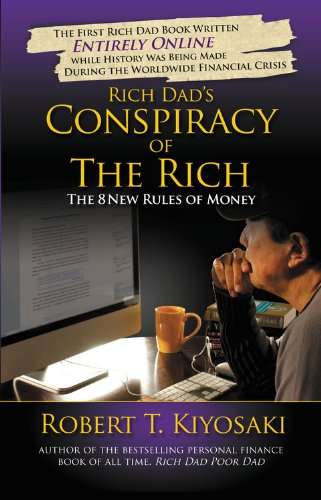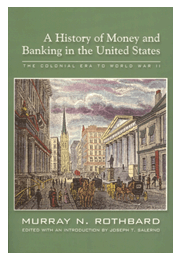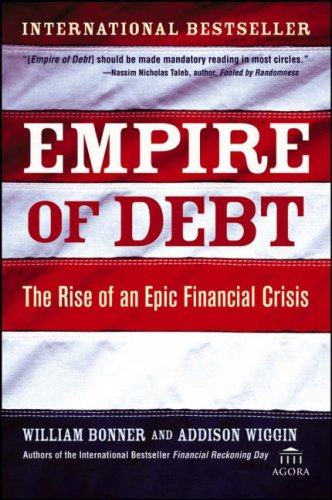
Rich Dad’s Conspiracy of the Rich: The 8 New Rules of Money
By Robert T. Kiyosaki
Robert Anton Wilson, in his book Everything Is Under Control, reported that “a random telephone survey of 800 American adults in September 1996 found that 74 percent – virtually three out of four citizens – believe that the U.S. government regularly engages in conspiratorial and clandestine operations.”
Robert Kiyosaki – the author of Rich Dad’s Conspiracy of the Rich – agrees with the 74 percent surveyed in 1996. As Kiyosaki writes in his book: “So has there been a conspiracy? I believe so, in a way.” He goes on to explain why he believes so, citing the lack of financial education in the school systems, the Federal Reserve Act, and Nixon’s 1971 dismissal of the gold standard. And most interestingly, Kiyosaki believes that 401(k) retirement vehicles placed the retirement money of average people in the hands of Wall Street.
The first chapter of the book is entitled ‘Can Obama Save the World?’ Kiyosaki’s answer is no. And apparently, Obama doesn’t want to even if he could. For he appointed Summers and Geithner, both of who played a part in repealing the Glass Steagall Act. In other words, it’s the same old same old. Nothing has changed. Which means that the average person needs to understand how taxes, debt, inflation, and retirement affect them. Kiyosaki sums up the chapter by stating that once one understands the new rules of money, then one can “opt out of the conspiracy of the rich.”
From there, Kiyosaki moves on to explain how we got where we are. He points the finger at the Federal Reserve Bank, which inflates the money supply, which destroys the value of savings and retirement plans. And he makes it very clear that the rules of money changed dramatically when the U.S. went off the gold standard in 1971. For up until that time, “technically, prior to 1971, the U.S. dollar was a derivative of gold. After 1971, the U.S. dollar became a derivative of debt.”
Kiyosaki proceeds to discuss what he calls ‘The Invisible Bank Robbery.’ He says “since money is invisible, a derivative of debt, bank robberies by bankers have become invisible.” Two ways these invisible robberies occur are: fractional reserve banking, which is nothing more than banks lending money they don’t have; and deposit insurance, which “protects the bankers – not savers.” Then he asks a very pertinent question: “why should an insurance company like AIG receive bailout money in the first place? Isn’t bailout money reserved for banks?” His answer is gloriously simple: “because it owed the biggest banks in the world a lot of money and didn’t have the cash to pay up.”
After allocating the first half of his book to talking about the conspiracy, Kiyosaki utilizes the second half of the book describing how to fight back. And although he acknowledges that the Fed is the culprit, he does not advocate abolishing it. For as he asks, “What would replace it? How much chaos would that cause? And how long would that take?” Instead, Kiyosaki advocates using the new rules of money to one’s advantage.
He lists five new rules at the beginning of the second part of the book. They are as follows: money is knowledge; learn how to use debt; learn to control cash flow; prepare for bad times and you will only know good times; and the need for speed. The latter rule – the need for speed – is an eye-opener. In other words, it should be read, memorized, and implemented by everyone.
In chapter seven, Kiyosaki explains why 90 percent of people are average. “They follow average advice.” Essentially, they follow “fairy tales of money.” The name of the game, according to Kiyosaki, is “cash flow.” People need to re-position themselves so they are playing the game and not just “pawns in the game.” He provides a great illustration – cell phones. “Every time you use your cell phone, cash flows from your wallet to the wallets of the cell phone businesses.”
To drive his point home, Kiyosaki sets out the attitudes and words of three different types of people, the poor, the middle class, and the rich. The focus has to be on cash flow, not on capital gains. And he explains that the cash flow techniques used by most average people do not work well because they are based on capital gains. In effect, what he is saying is if you can’t beat them (the conspirators), then join them. And he tells you how to do it.
Sophisticated investors – those focusing on cash flow – invest in four basic areas:
- Businesses that provide passive cash flow.
- Income-producing real estate.
- Paper assets – stocks, bonds, savings, annuities, insurance and mutual funds.
- Commodities – gold coins, silver coins, bullion bars, oil, platinum, etc.
According to Kiyosaki, the secret of success is sell. “In simple terms, if you can’t sell ‘tickets’ (derivatives of you), you have to sell your labor.” And in Kiyosaki’s opinion, the ultimate definition of “sell” is building a business and then taking it public. By selling more than you buy, you can eventually become rich.
Kiyosaki then states that he thinks the present financial crisis will only get worse, not better. Which mean that investing in businesses, real estate (using other people’s money), paper assets (using option strategies), and commodities is the only way to take advantage of the situation.
To take advantage, average people must become conversant in the language of finance, according to Kiyosaki. “Words have the power to make us rich – or poor.” And in his summary to the book, he reminds his readers that “knowledge is the new money.”


